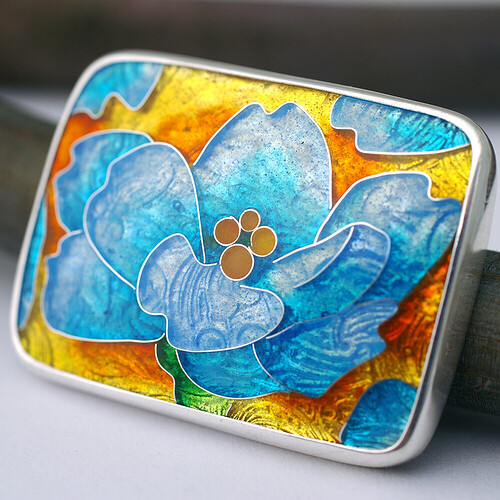Materials: fine silver, sterling silver, 24k yellow gold, enamel
Dimensions: 1 1/2 inch x 1 inch
This is a one of a kind handmade cloisonne enamel pendant, which features a blue and orange cherry blossom.
This enamel is made using fine silver, 24k yellow gold wire and beads, and translucent, opaque, and opalescent enamels. I hand grind all of my enamels to ensure that I get the brightest and highest quality colors possible. Each cloisonne wire was hand bent and filled with approximately 15 layers of colored and (for the final layers) clear enamel. fired in a kiln. The piece was then hand ground, polished and finally set into a handmade sterling silver bezel.
Photo credit: kyle anne judson
Kyle Anne Judson
Kyleannemetals
Athens, GA. USA
I am a formally trained Goldsmith and Cloisonne Enamelist, and I have over thirteen years experience in working with these mediums. From the time I was a small child I was obsessed with making jewelry, whether it was stringing glass beads, making beads out of fimo clay, and making earrings and pendants with friendly plastic. I took my first silversmithing class when I was sixteen and I know right then that this is what I wanted to do for the rest of my life. I am originally from Atlanta, GA and attended college at Savannah College of Art and Design. While I was there I fell in love with the art of enameling, and chose to further my education in this field. I apprenticed for an amazingly talented and wonderful Cloisonne artist named Ricky Frank. I spent four years learning everything I could from him and his Goldsmith Joanne Hernandez.
I started my business five years ago on etsy.com. I moved from Georgia to Santa Barbara, California and began to build my life there, focusing mainly on my business. I have recently moved back to Georgia, with the intention of going back to school and furthering my career.
The exhibition explores metal works whose primary theme is color embraced as their primary visual focus, whether that be using colored materials, exploring creating colored surfaces, or encasing the object in color.
As the world's largest jewelry related internet site, Ganoksin strives to develop exhibitions showcasing work from around the world. This exhibition was open to all metalsmiths, professional and amateur, advanced and beginner.
In total 303 artists contributed 814 show pieces for the permanent online exhibition.
The exhibition was curated by Beth Wicker, President of the North Carolina Society of Goldsmiths in the United States, and Adjunct Instructor at Northeastern Technical College in South Carolina. Director of the exhibition is Hanuman Aspler, founder of The Ganoksin Project, the world's largest internet jewelry site.
Hue is one of the primary properties of color, it refers to the place the color occupies on the visual spectrum. Humans have used hues throughout time, to create cave paintings, to decorate themselves, their clothing and their housing.
Different hues have taken on different meanings throughout time. Gold traditionally has been a color of purity - the metal gold is relatively unchangeable, and the hue of gold has come to stand for gods and goddesses, for royalty, for durability and for purity. Red has often meant love, or passion. Hues often reflect the meaning of the seasons, with pastels referring to spring and the burst of new life after the pale hues of winter. Summer is reflected in vibrant, deep hues, followed by the browning of hues in the fall as plants go to seed and die, and the land turns fallow.
The worth of a hue has often been tied to what is necessary to make the pigment that creates the hue, and the expensive involved in the process. Often created from crushed stones that had to be mined and carried by caravan over thousands of miles, or from fermented roots of plants only grown in certain areas, or the carapaces of rare insects - the creation of hue in a way that could be used by man was an involved and generally expensive process.
In today's world metalsmiths have access to perhaps the widest range of materials and hues in the history of man - and in some of the most affordable ways ever.
This exhibition celebrates hue - color - as an integral, inherent element of the work. We talk of the "richness" of color, and examples of this abound here. One expects hues from the colors of gemstones used in metalsmithing, but we also have hues from some less expected places. Glass enamels are an ancient way of adding color, as are a variety of patinas. Today's artists also use synthetic man-made materials to add color in ways that didn't exist a century ago.
We invite you to enjoy this celebration of hue, and the ways hues and their use have changed over time.
